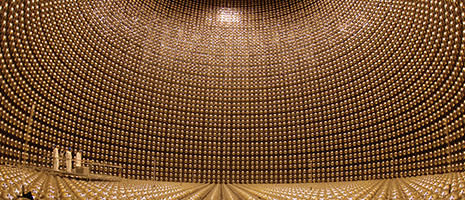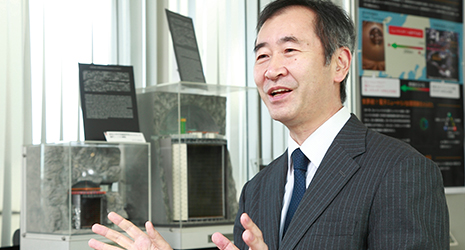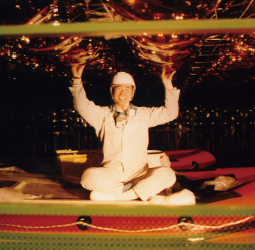Home > Highlighting JAPAN >Highlighting Japan January 2015>Science & Technology
Highlighting JAPAN


Neutrino Navigator
Nobel Prize winner Takaaki Kajita
Takaaki Kajita, director of the University of Tokyo’s Institute for Cosmic Ray Research, was awarded the 2015 Nobel Prize in Physics for the discovery of neutrino oscillation, which challenged the Standard Model of particle physics. Kajita spoke about the past and future of his neutrino research.
A neutrino is one of the fundamental particles of the universe. Produced in massive quantities at the moment of the universe’s creation 13.8 billion years ago, neutrinos are generated by the sun and through interactions between cosmic rays and atomic nuclei in the Earth’s atmosphere. The Earth itself is constantly bombarded by countless neutrinos; they literally permeate our lives.
But neutrinos are extremely light and can pass through any substance, making them almost impossible to see or capture. Neutrinos from the sun, for example, penetrate human bodies and even Earth itself, coming out the opposite side while rarely prompting a reaction, and it was long thought that neutrinos had no mass.
Nobel Prize-winning physicist Takaaki Kajita and his team, however, were the first to prove to the world that neutrinos do indeed have mass. There are three “flavors” of neutrinos—electron, tau and muon—but it had been suspected that, if neutrinos had mass, they could change from flavor to flavor as they propagate through space: in other words, a muon neutrino, for example, might change to an electron neutrino. This shift from flavor to flavor is known as neutrino oscillation.
At the Super-Kamiokande neutrino detector—located a thousand meters underground in the Kamioka Mine in Hida City, Gifu Prefecture—Kajita and his team discovered that almost half of the atmospheric neutrinos that came from the other side of the globe shifted from muon neutrinos to another neutrino flavor. When this discovery was presented in 1998, the scientists present reportedly gave a standing ovation lasting several minutes, and for good reason: the revelation contradicted the Standard Model of particle physics, which assumed that neutrinos have zero mass.
“We gradually uncovered proof of neutrino oscillation through experiments conducted over the course of approximately a decade, beginning at Kamiokande, Super-Kamiokande’s predecessor,” Kajita says. “I believe our results were made possible in large part due to our taking the global lead in creating such a unique facility as Super-Kamiokande, which could not have been created anywhere else.”
Kajita was involved in the planning of Super-Kamiokande, which features a deep subterranean tank holding fifty thousand tons of ultrapure water. When a neutrino collides with and reacts to the water molecules, the reaction is captured by an array of over ten thousand optical sensors. Four hundred quadrillion solar neutrinos pass through the array every second, but only ten reactions can be captured per day. However, within these tiny neutrinos are hidden the keys to unlocking the mysteries of space, such as supernovae and the origins of the universe.
“I believe that by examining neutrino oscillation in more detail, we will have the opportunity to learn how matter was created at the moment the universe was born,” Kajita says. “Also, if we were to study the approximately ten thousand neutrinos expelled during just ten seconds following the moment of a supernova, we would be able to explain what happens in the centers of the explosions that occur when heavy stars collapse.”
Even as Kajita’s research has unhinged fundamental concepts about the nature of the universe, it has opened up the possibility of resolving questions that have long plagued modern scientists. “The expansion of human knowledge enriches our lives,” Kajita says. And with that knowledge we may yet be able to trace our origins all the way back to the beginning of time.
© 2009 Cabinet Office, Government of Japan







